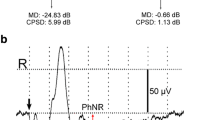Summary
This paper deals with the incline of the principal axis of the ellipse phenomenon (which in the frequency-range of 81–104 cps is perceived entoptically as a dark ellipse on a bright background and lies symmetrically to the fixation point) in the monocular visual field of 12 subjects. The principal axis of the EP 1 for the left eye always lay within the first and third quadrant and for the right eye within the second and fourth quadrant of the visual field. The mean of the tilt angle of the EP 1 (angle between the principal axis of the EP 1—projected on the retina—and the horizontal retinal meridian) had for all 12 subjects a value of |5,6°|±1° for the left and right eye.
For the 12 subjects also the angle between the horizontal retinal meridian and the connecting line (projected on the retina) of fixation point and mid-point of blind spot (so called tilt angle of the blind spot) was determined. A statistical examination however showed that a correlation between the tilt angle of the EP 1 and the papilla does not exist.
It is supposed that in regard to the anatomic structure of the retina, the ellipse always is caused on the same locus and that the inclined position of the EP 1 comes off that way that (for anatomical reasons) the retina of the subjects is rotated around the fixation axis in accordance to the incline of the EP 1.
Zusammenfassung
In dieser Arbeit wurde die Neigung der Hauptachse des im Frequenzbereich von 81–104 Hz angeregten Ellipsenphänomens (zum Fixierpunkt symmetrische, entoptisch wahrgenommene dunkle Ellipse auf hellem Grund [EP 1]) im monocularen Gesichtsfeld bei 12 Versuchspersonen untersucht. Die Hauptachse des EP 1 lag beim linken Auge stets im 1. und 3. Quadranten und beim rechten Auge stets im 2. und 4. Quadranten des Gesichtsfeldes. Im Mittel betrug der Neigungswinkel des EP 1 (Winkel zwischen der auf die Netzhaut zurückprojizierten Hauptachse des EP I und dem horizontalen Netzhautmeridian) bei den 12 Versuchspersonen beim linken und rechten Auge |5,6°|±1°.
Bei den 12 Versuchspersonen wurde auch der Winkel zwischen dem horizontalen Netzhautmeridian und der auf die Netzhaut zurückprojizierten Verbindungslinie von Fixierpunkt und Mittelpunkt des blinden Flecks (sog. Neigungswinkel des blinden Flecks) bestimmt. Eine statistische Beurteilung der Meßergebnisse zeigte jedoch, daß zwischen dem Neigungswinkel des EP 1 und dem des blinden Flecks kein Zusammenhang besteht.
Similar content being viewed by others
Literatur
Eisler, P.: Die Anatomie des menschlichen Auges. In: Schieck, F., und Brückner, A. (Hrsg.), Kurzes Handbuch der Ophthalmologie, Bd. I, S. 1–386. Berlin: Springer 1930.
Hering, E.: Die Lehre vom binocularen Sehen. In: Hering, E., Wissenschaftliche Abhandlungen. Hrsg v. d. Sächs. Akad. d. Wiss. zu Leipzig, Bd. 2, S. 1–146. Leipzig: Thieme 1931.
Kreyszig, E.: Statistische Methoden und ihre Anwendungen. Göttingen: Vandenhoeck & Ruprecht 1965.
Schober, H.: Das Sehen, 3. Aufl., Bd. 1. Leipzig: VEB Fachbuchverlag Leipzig 1960.
Trendelenburg, W.: Der Gesichtssinn, 2. Aufl. Berlin-Göttingen-Heidelberg: Springer 1961.
Warrington, E. K.: The effect of stimulus configuration on the incidence of the completion phenomenon. Brit. J. Psychol.56, 447–454 (1965).
Welpe, E.: Untersuchungen über elektrisch erzeugte Reizantworten des hell- und dunkeladaptierten menschlichen Auges (Ellipsenphänomen und galvanischer Pupillenreflex). Diss. TH München 1967.
— Über ein frequenzabhängiges Ellipsenphänomen bei elektrischer Reizung des helladaptierten menschlichen Auges. Pflügers Arch. ges. Physiol.298, 225–240 (1968).
— Anregung des Ellipsenphänomens durch die Harmonischen eines rechteckförmigen Reizstromes. Pflügers Arch.305, 9–20 (1969a).
— Anregung des Ellipsenphänomens durch sinusförmige Reizströme von 162–208 Hz und 287–324 Hz. Pflügers Arch.306, 304–319 (1969b).
— Periodische Größenänderung des Ellipsenphänomens bei intermittierender Belichtung des Auges. Z. Biol.116, 253–256 (1969c).
— Untersuchungen über die Lokaladaptation und das negative Nachbild des Ellipsenphänomens im Frequenzbereich von 81–104 Hz. Z. Biol.,116, 340–349 (1970).
Author information
Authors and Affiliations
Rights and permissions
About this article
Cite this article
Welpe, E. Über den Neigungswinkel des Ellipsenphänomens im monocularen Gesichtsfeld bei Frequenzen von 81–104 Hz. Albrecht von Graefes Arch. Klin. Ophthalmol. 180, 72–79 (1970). https://doi.org/10.1007/BF02384824
Received:
Issue Date:
DOI: https://doi.org/10.1007/BF02384824




